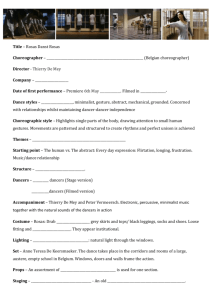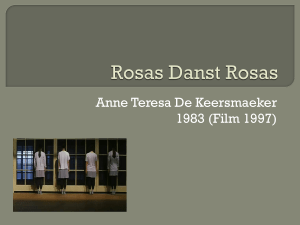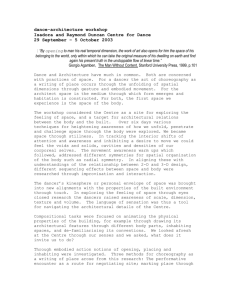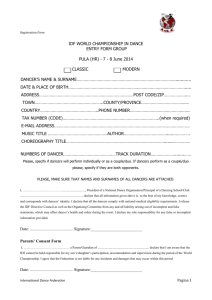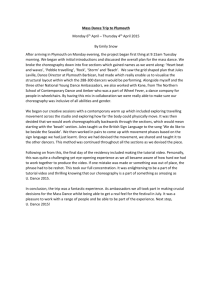ROSAS DANST ROSAS
advertisement
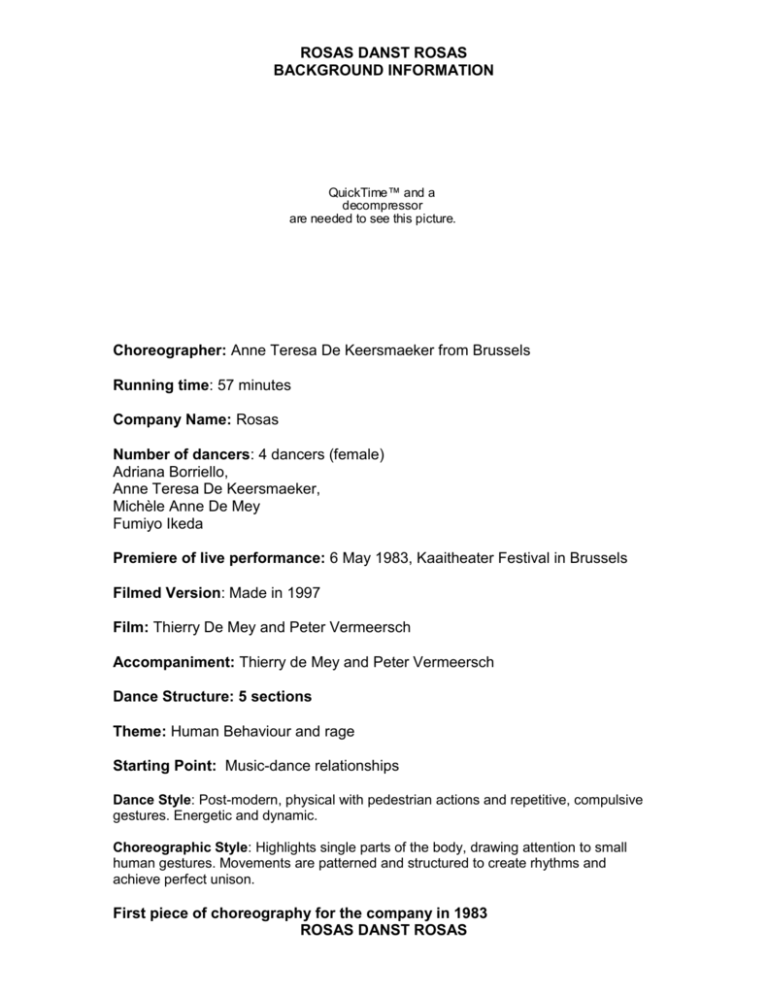
ROSAS DANST ROSAS BACKGROUND INFORMATION QuickTime™ and a decompressor are needed to see this picture. Choreographer: Anne Teresa De Keersmaeker from Brussels Running time: 57 minutes Company Name: Rosas Number of dancers: 4 dancers (female) Adriana Borriello, Anne Teresa De Keersmaeker, Michèle Anne De Mey Fumiyo Ikeda Premiere of live performance: 6 May 1983, Kaaitheater Festival in Brussels Filmed Version: Made in 1997 Film: Thierry De Mey and Peter Vermeersch Accompaniment: Thierry de Mey and Peter Vermeersch Dance Structure: 5 sections Theme: Human Behaviour and rage Starting Point: Music-dance relationships Dance Style: Post-modern, physical with pedestrian actions and repetitive, compulsive gestures. Energetic and dynamic. Choreographic Style: Highlights single parts of the body, drawing attention to small human gestures. Movements are patterned and structured to create rhythms and achieve perfect unison. First piece of choreography for the company in 1983 ROSAS DANST ROSAS CHOREOGRAPHY BY ANNE TERESA DE KEERSMAEKER COSTUME QuickTime™ and a decompressor are needed to see this picture. What constitutes as costume (List) Costume: • realistic, abstract • features: colour, texture, flow, shape, weight, decoration, line • accessories, footwear, masks and make-up • the relationship between costume and dance content. Describe the costume seen in Rosas Danst Rosas: A distinctive female look: full skirts, tomboyish boots. They are serious-looking women with civilian haircuts, wearing loose grey tops and skirts and brown, utilitarian brown plimsole/shoes. How does the choreographer use this costume? - Explain how the costume is used to enhance the choreography or theme: Drab colours are used such as everyday grey skirts and tops, black leggings, socks and shoes which are loose fitting and functional. All of these appear to make the females seem institutionalized. The costumes have a uniformity and do not individualise dancers – no personalities shine. Each dancer blends into one another. The costume is quite minimalist which compliments the music and physical setting. The slit neck top is used to enhance the movements of pulling down the neckline across the shoulder giving a raw, aggressive and yet seductive feel. The hair for some dancers is left down and not tied back so that in the chair section the hair is used to enhance the choreography on brisk lifts of the head, which exaggerates the action. ROSAS DANST ROSAS CHOREOGRAPHY BY ANNE TERESA DE KEERSMAEKER PHYSICAL SETTING QuickTime™ and a decompressor are needed to see this picture. Live version: set by Keersmaeker What constitutes as physical setting (List) Physical setting: • staging, for example: proscenium, in-the-round, site-specific, naturalistic, symbolic, abstract • set design, lighting, props, projection • features: colour, material, texture, decoration, shape, size, levels, placement • the relationship between the physical setting and dance content. Describe the physical setting of this professional dance work that you have studied. In the film version: Site specific - takes place in the corridors and rooms of a large, austere, empty school in Belgium. Windows, doors and walls frame the action. An assortment of wooden chairs is used for one section. Film: natural light through the windows. Choose one of the professional dance works that you have studied and explain how effective you think the use of physical setting is. I feel that the theme of this dance which is based on human behaviour and rage is clearly shown in Rosas because the set is empty allowing the dance actions to be clearly recognised and not pose a distraction for the viewers. The coldness that the austere rooms provide help to give a sense of institution where any comfort seems to be missing. The chairs help to give an institutional feel as though at school and the formal lines of them also help with this theme. The multi use of different rooms in the venue helps to add to the cold and sparce performance space and helps to set a location for the audience. The film version can do this extremely well although the stage performance in a proscenium arch stage setting is unable to get this message across so easily. The natural light coming through the windows also helps to create a dull and austere feel to the dance. Gives the feel of an institution, vast amounts of space, bare and cold. Very impersonal and harsh! ROSAS DANST ROSAS CHOREOGRAPHY BY ANNE TERESA DE KEERSMAEKER ACCOMPANIMENT By: Thierry de Mey and Peter Vermeersch Listen to the music on the video and answer these questions What constitutes as accompaniment/aural setting (List) Aural setting: • silence and accompaniment, for example, song, spoken word, natural/found sound, music from different times and places orchestral, electronic, • features such as: tone, texture, rhythm, dynamics, style, structure, orchestration, leitmotif • the relationship between music and dance content. What type of accompaniment is used in Rosas Danst Rosas? Electronic, percussive, minimalist music together with the natural sounds of the dancers in action. The accompaniment uses at times a score that pounds out a metallic rhythm. Explain how the accompaniment is used to enhance the choreography or theme: Music and choreography were written together during the course of the creative process, which explains the unison of musical and choreographic energy. The dance to music relationship in the repetitive metallic sections directly correlates but in the silence sections the dancers’ audible actions contrast to enhance the sounds and themes. The use of silence helps to reinforce the institution feel and also enables the viewer to concentrate on the human behaviour, which is reinforced by the actions/gestures. To help highlight the rage aspect of the theme the dancers’ breathing can be heard also accompanied by the purely ‘human’ music of panting, of arms tapping against the floor and the sound of rolling. (AUDIBLE ELEMENT OF DANCING). These sounds are repetitive which also helps to reinforce boredom. ROSAS DANST ROSAS CHOREOGRAPHY BY ANNE TERESA DE KEERSMAEKER Staging and Film Filmmaker and composer Thierry De Mey shot the film Rosas danst Rosas in June 1996 at the RITO School in Leuven (Belgium), a building designed by the architect Henry van de Velde. The film version is much shorter than the show itself. In his film Thierry De Mey opts for a heavily ‘inter-cut’ version in which, apart from the cast of four dancers from 1995 and 1996, he also has all the other performers from the long history of the show dance along. He makes maximum use of the geometrical and spatial qualities of the Van de Veldes building. One camera records the dance itself and a second highlights specific details using close-ups and panning camera movements. The camera becomes both composer and choreographer by selecting and layering images to create rhythms. Camera shots Using the pictures below describe what camera shot is being used and explain what impact this gives to the theme of the work. QuickTime™ and a decompressor are needed to see this picture. QuickTime™ and a decompressor are needed to see this picture. QuickTime™ and a decompressor are needed to see this picture. QuickTime™ and a decompressor are needed to see this picture. QuickTime™ and a decompressor are needed to see this picture. QuickTime™ and a decompressor are needed to see this picture. QuickTime™ and a decompressor are needed to see this picture. SPECIAL EFFECT – INTER CUTTING to give the impression of more dancers. Makes good use of the frames of windows and doors to help with this special editing effect. List the advantages of using film for dance List the disadvantages of using film for dance ROSAS DANST ROSAS CHOREOGRAPHY BY ANNE TERESA DE KEERSMAEKER CHOREOGRAPHY Dance Style - Post-modern, physical with pedestrian actions and repetitive, compulsive gestures. Energetic and dynamic. Choreographic Style - Highlights single parts of the body, drawing attention to small human gestures. Movements are patterned and structured to create rhythms and achieve perfect unison. Starting Point – Music–dance relationships In Rosas danst Rosas, which has in the meantime been filmed under the same title, two sorts of movement are interwoven with each other. On the one hand there are abstract movements that are hard to label, and on the other, more concrete, recognisable gestures are also used: running the hand through the hair, pulling a blouse straight, a sudden turn of the head, etc. These gestures have a direct significance because they refer to everyday movements. It seems as if minor occurrences during the working process have crept into the performance as literal quotations. But it is not only by way of the movements that the performance’s illusory closeness (‘it’s only dance’) is constantly broken open towards a more mundane reality. For instance, in the intermezzo between the first and second parts, the dancers themselves put out chairs and shoes, iron their clothes, and clearly take the time to get their breath back. And again, at the end of the fourth, physically very demanding part, the dancers openly show their fatigue: they stand there audibly panting and visibly sweating on stage. These short moments show, as it were, the physical ‘reverse side’ of dancing as an art of the body. One will not see this in classical ballet performances; even performances of modern choreographies usually involve the concealment of effort and fatigue. By contrast, in De Keersmaeker’s work, also after Rosas danst Rosas, there is often a denial of the illusion that a dance performance shows a reality totally different from that of everyday physical life. It can be seen, for example, that De Keersmaeker never aspires towards supremely perfect performances of her choreographic works: she allows her dancers to carry out simultaneous movements with less than absolute perfection. For this reason performances by Rosas always have a particular expressiveness and ‘humanity’. Film Analysis The film starts with a female dancer placing a chair down in a corner of a room and then pacing between a door. We then hear running and footsteps in the building (camera shots begin as though we are looking in from the outside on the events and then passes into the rooms). It is quite dark so gives a dull depressing feel to the piece. Linear pathways are walked through the building to reinforce the linear window/door frames and empty rooms. The women line up along a window in canon as through lining up for a register and then begin the first section by collapsing on the floor, one of them De Keersmaeker. They are serious-looking women with civilian haircuts, wearing loose grey tops and skirts and only socks (no shoes in the floor section). For at least 12 minutes, there is no music, just the breathing of the performers as they execute a series of gestures. Bodies roll from side to side like bolts of cloth, drawing the loose drapery of their costumes with them. Arms are raised, hands touched to hair, rises initiated and abandoned with a soft collapse of limbs. Occasionally, like starlings on a wire, the dancers gaze intently before them. More often, their eyes are half-closed. To begin with you expect some kind of development, but then you realise that this is it. This is as eventful as it's going to get. This section ends with all four dancers lying on their sides with their heads perched awkwardly. The camera then picks up on this position but one of the dancers is now on a chair in the similar position 12.08 - The second movement takes place in small rows of diagonally positioned chairs The movements consist of quick, hard, energetic gestures responding to the percussive music with its metallic-sounding beats. At once half-hynotised and hyper-receptive, we move into part two, which seems to be an allegory of industrial process, and of the social and domestic activities imposed on women. As the dancers' hair swings around their heads, their arms reach out and retract like pistons, and their faces take on a frazzled cast. The sequence looks at times like an out-take from an early Soviet propaganda film, but the cheerful, workerbee ethic is undercut by the visible strain manifested by the performers, and by gestures which appear at once abject and flirtatious: the pensive baring of a shoulder, perhaps, or of the upper curve of a breast. There's always been an exhibitionistic edge to De Keersmaeker's work, with much fussing with bras and kicking off of knickers, which sits oddly with her unsmiling severity. In fact, she's just messing with your head, challenging you to ascribe emotional meaning to purely mechanical gestures. At about 20:05 on the film a CLIMAX is clearly evident – The film is cut and edited at a fast speed with changes of viewing points and camera shots to help give a sense of climax and finishes with the dancers slumped in the chair in a heavy twisted sitting position facing towards the back as if someone has just walked in on them. The aggressive dynamics and faster actions of the dancers accompanied by heavy breathing sounds builds the tension of the piece hence giving a climatic ending to the section. 12.14 - We then switch to a corridor and a door with steps which a dancer walks through and performs a gestural dance phrase on. We now see the pacing motif displayed. The third part is, like the first, a play between straight lines and diagonals, which is accentuated by the corridors of light in which they move. The chance or deliberate baring of one shoulder (the ritual of seduction?) Is one of the most striking concrete gestures in this section. Lots of repetition of this motif with dancers on different levels and facing different directions moving on linear pathways, which reinforce the walls and windows. The steps/ and different levels create depth in the choreography. Numbers of groups are varied in this section with film editing to add numbers of dancers. There is lots of use of foreground and background, which adds depth to the choreography. The fourth section is a group dance and moves with a marked crescendo to the limits of physical exhaustion; diagonals, straight lines and circles alternate. The closing section is a very short coda consisting only of genuine, concrete gestures linked to the dancers’ exhaustion. There is still a great deal of dancing by the four women in unison throughout the piece, but even so all possible variations on the number four are tried out. For example, three dancers make the same movement, while the fourth goes counter to it; or they follow a course two by two, or one plus one plus two, or one plus two plus one, and so on. In Rosas danst Rosas several areas of tension also arose for the first time which were to become characteristic of the whole of De Keersmaeker’s later work. In particular there is the contrast between rational (‘premeditated’) structures and meaningful emotions, the dialectic between aggression and tenderness, or the interaction between uniformity (of clothing or movements) and individuality (the separate accentuation of their identical clothing by means of the dancer’s varying physiques, or the individual accents in the execution of movements in unison). The dancers all run out of the school leaving a dancer holding a clenched fist seen as a close up.
